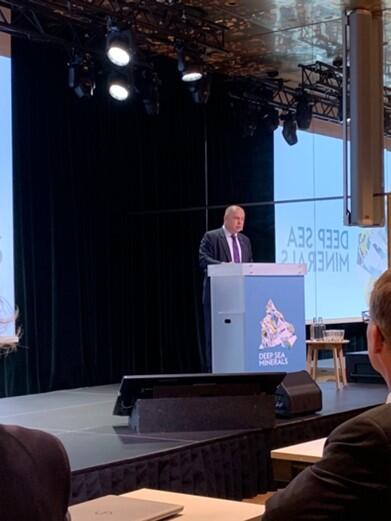Deep Sea Minerals Conference Bergen 2022
Environmental considerations were the main subject for discussion among the companies represented on the Deep Sea Minerals Conference which was held in Bergen on 26-27 of October this year. Research assistant Mari Bygstad was one of the participants attending as a part of her master thesis research project.

Main content
Population growth, increased prosperity as well as the Paris Agreement's goal to limit emissions of greenhouse gases, leads to an increased demand for marine minerals. Minerals such as cobalt, nickel, manganese, copper, zinc and rare earths are required to enable the energy transition, because they are essential in the production of green technology such as windmills and batteries used in electric cars. These minerals are found on the seabed in the world's oceans, and they contain a higher metal concentration than the mineral deposits found on land. According to the International Energy Agency, the demand for minerals may be four times greater as early as in year 2040, and seabed minerals can therefore play a key role in the green transition. In Norwegian sea areas, mineral deposits have been detected, and the Ministry of Petroleum and Energy is already surveying the possibilities for mineral extraction on the Norwegian continental shelf. The Seabed Minerals Act was adopted in 2019, and in 2020 the Ministry of Petroleum and Energy initiated an opening process.
The challenge, however, is to locate deposits that can form a good resource estimate, to develop technologies for exploration and economic extraction with limited effects to the environment, as well as to establish knowledge and information on the harmful effects any extraction may have on the natural diversity in the sea. Knowledge about the environmental effects is critical and must be taken seriously. Environmental considerations were the main subject for discussion among the companies represented on the Deep Sea Minerals Conference which was held in Bergen on 26-27 of October this year. I was one of the participants attending as a part of my master thesis research project.
The conference was opened by the President of the Cook Islands, Mark Brown, which is the first country in the world to open for deep sea mineral exploration. The Cook Islands have this year awarded three exploration licenses and are among the world leaders in the search for the critical minerals. The authority delegation talked about the process up to the awarding of the licenses, and shared their experiences and actions taken to minimise the environmental consequences.
On the first day of the conference, the International Seabed Authority and the Ministry of Petroleum and Energy were also represented, as well as several key players from the geoscience community. The focus on protection of vulnerable habitat types and species in vulnerable areas were all important subjects for discussion, and the companies shared their research experience monitoring biological diversity, fauna and possible environmental impacts.
On day two of the conference, technological solutions for extraction and processing were on the agenda, and both Norwegian and international companies were represented. On this day, the Norwegian Ministry of Petroleum and Energy also published the impact assessment report, which was presented by the state secretary of the Ministry of Petroleum and Energy, Andreas Bjelland Eriksen. The Norwegian Petroleum Directorate then presented the report's overall conclusions, which can be read here. Norway's experience from the oil and gas sector is highlighted as crucial, as we have considerable experience in environmental monitoring, technology development and management of natural resources required in the deep-sea mining industry.
The impact assessment report will now be sent for public consultation, which in turn will be a part of the decision-making for the opening process. According to the plan, the opening announcement will be submitted for consideration in Stortinget during spring 2023, where it now remains to be seen whether the knowledge base is considered to be sufficient. See the overview of the various phases for examination and extraction of seabed minerals in the figure below.
